Cultural Tourism
Yulin Karst Caverns Health Resort Project of Tonghua City
1. Introduction to the Project
1.1 Project background
1.1.1 Product introduction
With the development of China’s economy and society, the improvement of people’s living standards, and the increasing demand for health and physical fitness among the population, China will enter an aging society. The aging problem is becoming increasingly severe, and the “big health” industry is rapidly entering a new round of growth. As a health tourism that combines tourism and the “big health” industry, it has a good market environment.
Gong’an Village, Yulin Town, Ji’an City, belongs to the karst landform and is the only karst cavern resource landscape group discovered in Ji’an City so far. The Yulin Karst Caverns Health Resort Project in Tonghua City fully utilizes local resources such as ecology, mineral springs, cold springs, natural products, forests, and anti-Japanese Aggressors Alliance relics, integrates leisure and vacation functions and characteristic industries, and creates a health combination tourism product with karst cavern resources, mineral resources, ecological resources, and red sites as the core. The project aims to create a combination of health and wellness tourism products, integrating various industries such as health preservation, elderly care, tourism, and culture. This will help promote the optimization and upgrading of the industrial structure and contribute to the development of the tourism industry in Tonghua City.
1.1.2 Market prospect
(1) Analysis of China’s tourism market
According to the data from the National Bureau of Statistics, the number of domestic tourists in China has steadily increased year by year since 2010, reaching 6.006 billion in 2019, with an average annual compound growth rate of 12.4%. However, with the outbreak of the global COVID-19 pandemic in 2020, the number of domestic tourists will decline significantly from 2020 to 2022. In 2022, the number of domestic tourists reached 2.53 billion, a year-on-year decrease of 22.06% and a decrease of 57.9% compared to 2019.
2023 is a year of strong recovery for the tourism industry, as the suppressed demand for travel for three years is released and tourism gradually becomes a way of life for people, sparking a new wave of national travel. According to the Statistical Bulletin on National Economic and Social Development of the People’s Republic of China in 2023 released by the National Bureau of Statistics, there were 4.89 billion domestic trips in 2023, an increase of 93.3% over the previous year. Among them, urban residents traveled domestically 3.76 billion times, an increase of 94.9%; rural residents traveled domestically 1.13 billion times, an increase of 88.5%. 82.03 million inbound tourists, including 13.78 million foreigners and 68.24 million compatriots from Hong Kong, Macao and Taiwan. There were 100.96 million domestic residents who left the country, including 96.84 million for personal reasons and 77.04 million for travel to Hong Kong, Macao, and Taiwan.
Figure 1 Domestic Tourist Arrivals and Growth in China from 2016 to 2023
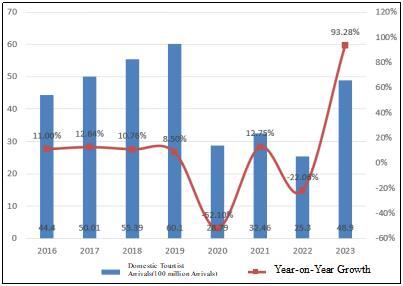
In 2023, the domestic tourism revenue (total travel expenses) reached 4.91 trillion yuan, an increase of 2.87 trillion yuan from the previous year, a year-on-year growth of 140.69%, a significant increase, reversing the sluggish situation since 2020. At the same time, compared with 2019 before the pandemic, the domestic tourism revenue in 2023 has recovered to 85.69% of the same period in 2019, significantly narrowing the gap and demonstrating the vitality and potential of domestic tourism consumption. In 2023, the total travel expenses of domestic tourists in China were 4178.1 billion yuan for urban residents, an increase of 147.5%; rural residents spent 735.3 billion yuan on travel, an increase of 106.4%. The total cost of inbound tourists was 53 billion US dollars.
Figure 2 Domestic Tourism Revenue and Growth in China from 2016 to 2023
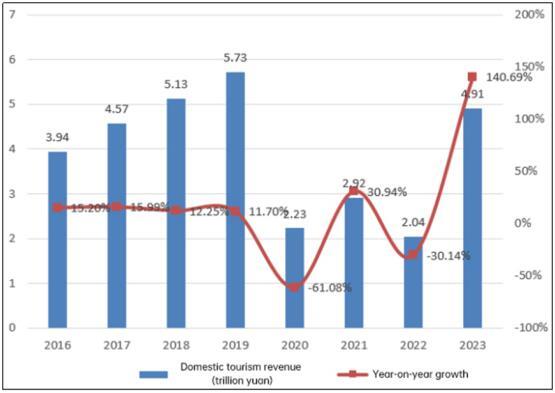
The development of the cultural and tourism industry is an important part of the construction of national cultural confidence. In recent years, it has received attention from the country and policies such as the 14th Five-Year Plan for Cultural Development and the 14th Five-Year Plan for Tourism Development have been successively issued to promote the integration of culture and tourism, increase the supply of cultural and tourism products, and improve the quality of cultural and tourism products.
In recent years, people have been pursuing more innovative and proactive tourism products, and the simple leisure and sightseeing activities of mountain and water travel have gradually been replaced by diversified tourism methods and projects. New models such as urban strolls, health tourism, ecotourism, industrial tourism, and cultural tourism are gradually developing and growing.
According to the domestic tourism data in 2024 released by the Ministry of Culture and Tourism, based on the results of a sample survey of domestic tourism, the number of domestic tourists in 2024 was 5.615 billion, an increase of 724 million from the same period last year and a year-on-year growth of 14.8%. among them, the number of domestic trips by urban residents reached 4.37 billion, a year-on-year increase of 16.3%; the number of domestic trips by rural residents reached 1.245 billion, a year-on-year increase of 9.9%.
(2) Development status and forecast analysis of tourism in Jilin Province
Jilin Province covers an area of 187400 square kilometers, accounting for 2% of the total national area. Located in the central part of Northeast China, in the heartland of Northeast Asia consisting of Japan, Russia, North Korea, South Korea, Mongolia, and Northeast China. It borders Heilongjiang Province to the north, Liaoning Province to the south, Inner Mongolia to the west, Russia to the east, and North Korea across the Tumen River and Yalu River to the southeast. The location advantages are obvious, and there are good conditions for developing the tourism industry.
Jilin Province has a variety of natural landscape types with high quality, and profound cultural connotations in its cultural landscapes. Compared with similar domestic tourism resources, the tourism resources with comparative advantages include Changbai Mountain forest ecological tourism resources, ice and snow tourism resources, ethnic cultural tourism resources, and border tourism resources.
In recent years, tourism in Jilin Province has entered a fast lane of development, with a comprehensive layout of industries. The “dual-ring line” of east-west tourism and the “dual-industry” structure of ice and snow and summer resort have been basically formed in the province. The transportation and other hardware support required for the development of the tourism industry are increasingly strengthened, and the supply of tourism products is becoming more diversified.
In 2023, Jilin Province received 314 million domestic tourists, a year-on-year increase of 172.8%, returning to 126.5% of the same period in 2019; domestic tourism revenue reached 527.735 billion yuan, a year-on-year increase of 242%, recovering to 107.3% of the same period in 2019. The number of tourists and tourism revenue have reached the best historical level.
The cultural and tourism system in Jilin Province conscientiously implements the work deployment of the Provincial Party Committee, the Provincial Government, and the Ministry of Culture and Tourism, takes multiple measures, and comprehensively stimulates the potential of cultural and tourism consumption. The province has abundant supply of tourism products, and citizens and tourists are actively traveling, leading to explosive growth in the tourism market.
(3) Market analysis of the health and wellness tourism industry
According to the National Health and Wellness Tourism Demonstration Base Standards, health and wellness tourism is defined as the sum of various tourism activities that enable people to achieve a natural and harmonious state of mind, body, and spirit through various means such as beauty and fitness, nutritious diet, mental cultivation, and environmental care.
Practice precedes theory in the development of health tourism in China. In 2002, Sanya, Hainan Province, was the first to introduce health tourism, but its development scale was limited. In 2012, Panzhihua proposed to develop a national “health and wellness tourism” city, and China’s health and wellness tourism market began to develop rapidly. In January, 2016, the National Tourism Administration released the National Health and Wellness Tourism Demonstration Base Standard and clarified the concept of “health and wellness tourism”. Health and wellness tourism was officially included in the country’s economic development strategy. The comprehensive emphasis on health and wellness is one of the important signs of economic and social development, which is the progression from survival to daily life, and the emphasis on food and clothing to quality living. Since the 14th Five-Year Plan, the country has explicitly stated in relevant plans to vigorously promote the construction of health and wellness tourism demonstration bases, leading to a rapid development trend in the industry.
With the development of China’s economy and society, the improvement of people’s living standards, and the increasing demand for health and physical fitness among the population, China will enter an aging society, and the aging problem will become increasingly severe. At present, 70% of the population in China is in a sub healthy state, 21% of the elderly population over 60 years old, 15% of the population in a diseased state, and over 400 million middle-class people pursuing a high-quality life, all of which provide a huge market for health tourism.
According to relevant data and predictions, the size of the health and wellness tourism market has grown from about 40 billion yuan in 2015 to nearly 105 billion yuan in 2023, with an average annual compound growth rate of 13.10%. It is expected that by 2028, the size of China’s health and wellness tourism market will have approached 160 billion yuan.
Figure 3 Scale and Growth Rate of China’s Health and Wellness Tourism Market from 2015 to 2023
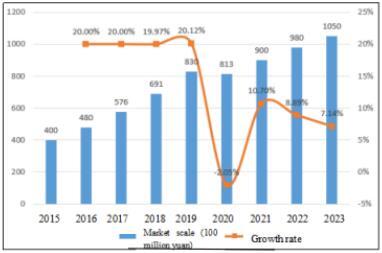
The karst caverns have been discovered in the mountainous area of Zhi’an Village, Yulin Town, Ji’an City. After more than a century of gradual discovery, the scale has begun to emerge. In the several excavated caverns, various types of stalactites, wall flow stones, stone curtains, and stone tents can be seen everywhere, as well as murmuring water. According to preliminary calculations, there are large karst caverns with an area of tens of thousands of square meters within the local mountain range. This karst caverns were formed by the precipitation of metamorphic rocks and associated quartzites from the Middle Upper Proterozoic 1.85 billion years ago, through geological mechanics and plate theory of the “Yanshan Movement” faults, folds, and uplifts.
The project utilizes abundant local tourism resources to construct Yulin Karst Caverns Health Resort, creating a combination of health and wellness tourism products. The project has a broad market prospect.
1.1.3 Advantageous conditions of project construction
(1) Policy advantages
In 2016, the State Council pointed out in the Healthy China 2030 Planning Outline that the integration of health and pastoral, pension, culture, tourism, the Internet, fitness and leisure, and food should be actively promoted to promote the upgrading of new health industries, new formats, and new models and the evolution of the industrial chain.
In June, 2021, the Ministry of Culture and Tourism released the 14th Five-Year Plan for Cultural and Tourism Development, which clearly stated the development of health tourism and the promotion of the construction of national health tourism demonstration bases.
In December, 2021, the State Council released the 14th Five-Year Plan for the Development of the National Aging Industry and Elderly Care Service System, which clearly proposed to promote the integrated development of elderly care and tourism. Guide various tourist attractions and resorts to strengthen aging friendly construction and renovation, and build health tourism bases.
The No. 1 Document of the Central Government in 2024 encourages local governments to vigorously develop characteristic industries in line with local conditions, and supports the creation of local characteristic brands. Implement the deep integration project of rural culture and tourism, promote the construction of rural tourism clusters (villages), cultivate new formats such as ecotourism, forest health, and leisure camping, and promote the standardized development and quality improvement of rural B&B. Optimize the implementation of rural industrial integration development projects and cultivate agricultural industrialization consortia.
At the end of 2024, the Central Economic Work Conference proposed to innovate diversified consumption scenarios, expand service consumption, and promote the development of cultural tourism industry.
In August, 2023, the Department of Culture and Tourism of Jilin Province released the Development Plan for Ecotourism in Jilin Province (2022-2030), proposing that by 2025, the total number of tourists received in the year will have exceeded 100 million, the number of inbound tourists will have exceeded 1 million, the total tourism revenue will have exceeded 200 billion yuan, and the “dual gateways” and “dual green hearts” will have been built. It will initially become a strong province for year-round ecotourism in China and an internationally first-class destination for summer leisure and ice and snow vacation ecotourism.
In October, 2023, Jilin Provincial Party Committee and Jilin Provincial People’s Government issued the Action Plan for Tackling the Trillion-level Tourism in Jilin Province (2023-2025), proposing to reach 720 billion yuan by 2025 and strive to achieve the goal of the trillion-yuan tourism within five years.
In March, 2023, the National Development and Reform Commission agreed to establish a demonstration zone for industrial transfer in southwestern Jilin, focusing on enhancing industrial transfer capacity, optimizing business environment, deepening open cooperation, effectively undertaking domestic and foreign industrial transfer, promoting industrial transformation and upgrading in the process of undertaking, and striving to build the demonstration zone into a characteristic manufacturing base in Northeast China, a green and low-carbon transformation pilot zone, a new highland for regional cooperation and development, and an important agricultural and special product processing base in the country. The demonstration zone covers three cities: Siping, Liaoyuan, and Tonghua.
(2) Resource advantages
Ji’an has a long history. It was once the ancient capital of Goguryeo, with rich historical and cultural relics, such as the the Capital Cities and Tombs of the Ancient Goguryeo Kingdom. Ji’an is also a world cultural heritage site and a famous historical and cultural city in China, known as the “City in the south of the Yangtze River of Northeast China”. It has a pleasant climate and beautiful scenery. The main attractions in Ji’an include Wunvfeng National Forest Park, Yalu River Scenic Area, Yunfeng Lake Scenic Area, and Haotaiwang Stele. In addition, Ji’an has been rated as a national health city, national garden city, and national ecological civilization construction demonstration city and county, etc.
Yulin Karst Cavern in Tonghua City is part of the largest karst caverns discovered in the three provinces of Northeast China so far. The scale of the karst caverns is grand, with the glaze cavern as the center. Within a radius of 50 square kilometers, the karst caverns are widely developed, and within a radius of 5 square kilometers, there are multiple larger karst caverns concentrated and developed, making them a unique landscape in Jilin Province.
(3) Industrial advantages
In recent years, Ji’an City has fully utilized cultural advantages such as rural history and culture, regional culture, and folk culture, integrating them with the beautiful ecology of the local area. While improving the appearance of villages, it has also enriched the connotation of rural tourism in the city. In 2023, Ji’an City focused on building the rural tourism brand of “28 Villages by the Yalu River”, with 28 key villages as pilot projects, endowing cultural brands with creativity and visual image design, vigorously carrying out cultural empowerment work, integrating cultural achievements into the infrastructure and industrial development process of key villages, and gradually making them unique rural tourism products. At present, rural tourism brands such as “Grape Charm Town” in Huangbai Village, Qingshi Town, “First Ferry of Aid to North Korea” in Xiajiefang Village, Chengdong Street, “Fruits·Lodge” in Qianwan Village, Taiwang Town, and “Fishing· Dock” in Huolong Village, Maxian Township, have deeply implemented the “tourism+” development strategy. While realizing the transformation of “farmland into scenery, farmhouses into guest rooms, and agricultural products into gifts”, they have also added a unique charm to the recovery of the city’s tourism.
(4) Location advantages
Ji’an City is located in the southeast of Jilin Province and the south of Tonghua City, at the southwest foot of Changbai Mountain, adjacent to 5 districts and counties, with a total area of 3341 square kilometers. The urban area of Ji’an City is 103 kilometers away from the highway of Tonghua City, 422 kilometers away from the highway of the provincial capital Changchun City, and 260 kilometers away from the highway of Dadonggang in Liaoning Province.
Ji’an City is located in the core area of the Yalu River International Economic Cooperation Belt, facing Manpo, Chasong, Chosan, and Wiwon of the Democratic People’s Republic of Korea across the river, with a border line of 203.5 kilometers. Ji’an Port is one of the three major ports for China’s trade with North Korea and the only port city in Tonghua City. The China-North Korea international trains travel between the two countries every day and it is an important gateway for Jilin Province to open up to the south.
There are two dedicated railways in Ji’an City, international and domestic railways. The Ji’an Railway runs through the north and south, providing direct access to Beijing, Changchun, Qingdao, Dalian and other places. The cross-border railway connects with Manpo in North Korea and reaches the hinterland of the Korean Peninsula. The domestic railway is mainly the Tonghua-Ji’an section of the Meihekou-Ji’an Line, with a length of 46 kilometers. It is a major transportation artery that crosses the southeast of Tonghua City, Tonghua County, and Ji’an City, and is also an important railway transportation line in Northeast China; the international route from Ji’an to Manpo in North Korea, with a length of 8 kilometers, is one of the important routes for China to North Korea.
(5) Talent advantages
At present, Tonghua City has 3 national key secondary vocational schools, 3 provincial key secondary vocational schools, and all county-level vocational education centers have passed the provincial key school acceptance and entered the top 100 schools in the province. It is the first region in the province where all county-level vocational education centers have entered the provincial key school list. In recent years, through scientific layout, continuous promotion of vocational education structure adjustment and resource integration, exploration of new paths for diversified education, continuous improvement of modern vocational education network system construction, the local characteristics of vocational education have begun to form, and the ability to serve economic and social development has gradually improved.
Tonghua Municipal Government has signed technology strategic cooperation agreements with research units of provincial universities such as Northeast Normal University, Jilin Agricultural University, Changchun Institute of Chemical Engineering, Chinese Academy of Sciences, and Tonghua Normal University, providing technological support for the development of enterprises. Tonghua City continues to provide assistance to enterprises in talent cultivation and other aspects, vigorously implementing the “Ten Thousand Students Revitalizing Enterprises Plan and Thousand Students Returning Home Plan, and continuously attracting college graduates for enterprises.
1.2 Contents and scale of project construction
The total area of the karst cavern landscape distribution area is about 50 square kilometers, and the project planning area is 22.65 square kilometers. It is mainly to utilize the unique karst landscape of the karst caverns, and four experience areas are created:
(1) Fantasy karst cavern experience area. Develop and construct six major karst scenic spots, namely, “Red Army Cavern”, “Bat Cavern”, “Water String Cavern”, “Wind Cavern”, “Dark Cavern”, and “Underground River”, and establish a tourist reception service area.
(2) Cold spring wonderland experience area. Develop and construct a health resort that integrates the Taoist culture of “heavenly paradise and blessed land”, and create a high-end clubhouse. Develop a high-end cave themed mineral spring SPA center for summer cold spring SPA and winter spa SPA.
(3) Rehabilitation experience area. It is to construct a resort hotel, rely on the resources of mountains, forests, and water systems, drawing on the theory of environmental aroma therapy and traditional Chinese medicine health formulas, and combine the planting of Chinese herbal medicine and special plants with strong aroma, to make the air have health and fitness effects. It is divided according to different functions, such as awakening area, happy area, stomach health area, mosquito free area, bird attracting area, etc., so that tourists can maintain their health during the tour.
(4) Beautiful countryside experience area. It combines the surrounding rural resources to create an ecological agricultural picking garden and vacation car campsite.
1.3 Total investment of the project and capital raising
1.3.1 Total investment of the project
The total investment of the project is 600 million yuan, including the construction investment of 570 million yuan and current funds 30 million yuan.
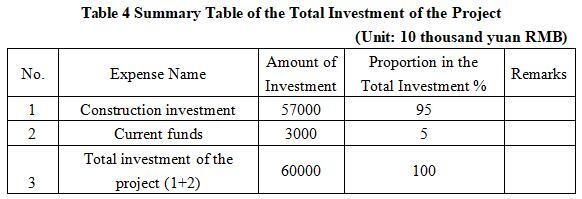
1.3.2 Capital raising
Self-raising by the enterprise。
1.4 Financial analysis and social evaluation
1.4.1 Main financial indexes
After the project reaches the production capacity, its annual sales revenue will be 200 million yuan, its profit will be 120 million yuan, its investment payback period will be 7.0 years (after the tax, including the construction period of 2 years) and its return on investment will be 20.0%.
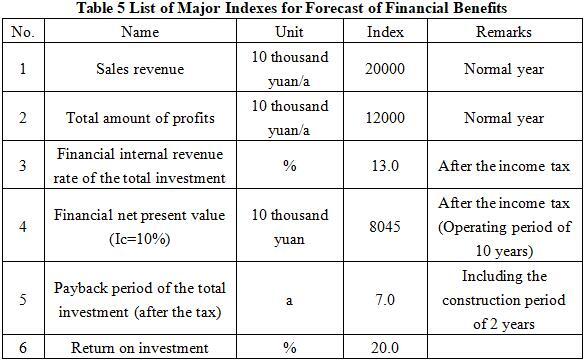
Note: “10 thousand yuan” in the table is in RMB.
1.4.2 Social evaluation
The project builds a health resort that integrates various industries such as health preservation, elderly care, tourism, and culture, achieving complementarity and win-win among industries, which helps to promote the optimization and upgrading of industrial structure; it satisfies the increasingly diverse needs of the people and improving their quality of life; it can also drive the development of the local service industry, catering industry, accommodation industry and other related industries, create employment opportunities, and promote economic growth.
1.5 Cooperative way
Sole proprietorship or joint venture
1.6 What to be invested by the foreign party
Funds and others
1.7 Construction site of the project
Zhi’an Village, Yulin Town, Ji’an City, Tonghua City
1.8 Progress of the project
The project proposal has been prepared.
2. Introduction to the Partner
2.1 Basic information
Name: Ji’an Municipal Bureau of Culture, Radio, Television and Tourism
Address: 3001 Yajiang Road, Ji’an City
2.2 Overview of the Partner
Located in the southeast of Jilin Province, Ji’an City covers an area of 3341 square kilometers. It has jurisdiction over 1 provincial economic development zone, 11 towns, 4 streets, 127 administrative villages, a total registered residence population of 202547, 25 ethnic groups including Han, Korean, Manchu and Hui. It is a world cultural heritage site, a famous historical and cultural city in China, a national ecological demonstration area, an excellent tourist city in China, a national leisure agriculture and rural tourism demonstration county, a hometown of Chinese calligraphy, a national garden city, and one of the top ten frontier cities in China. The GDP grew by 5.6% year-on-year in 2023.
Ji’an has four major business cards: firstly, it is a world heritage ancient capital. Ji’an has a long history and rich cultural heritage. The Goguryeo ethnic group, which existed for 705 years during the Han and Tang Dynasties, thrived and established its capital in Ji’an for 425 years, passing down 19 generations of kings and leaving behind a large number of cultural relics and historical sites. So far, more than 10000 ancient sites and ancient tombs have been found in Ji’an. the Capital Cities and Tombs of the Ancient Goguryeo Kingdom have been included in the World Cultural Heritage List. Ji’an is the 30th world cultural heritage site in China. The second is the hometown of national ginseng. Ji’an has been one of the main production areas of ginseng, known as the “King of Herbs” since ancient times. Ginseng has a history of over 1700 years of application and nearly 500 years of artificial cultivation. Ji’an ginseng is superior in quality, beautiful in shape and high in saponin content. It is known as the top grade of ginseng, with an annual output of about 4000 tons of fresh ginseng. The “Xinkaihe” brand is the first well-known trademark in China’s ginseng industry, and the “Ji’an Qinghe wild ginseng” is a national geographical indication protection product. The quality of ginseng represents the highest level of Changbai Mountain ginseng, which is the world’s highest quality ginseng production area and the largest underforest ginseng base. The third is a border town. Ji’an is located in the core area of the Yalu River International Economic Cooperation Belt, facing Manpo, Chasong, Chosan, and Wiwon of the Democratic People’s Republic of Korea across the river. The border line is 203.5 kilometers long, and the domestic port authorities are complete. International trains between China and North Korea travel between the two countries every day, making it an important window for Jilin Province to open up to the south. The fourth is a place of health and prosperity. The forest coverage rate has reached 82.19%, and the proportion of days with excellent air quality has exceeded 90%. The favorable ecological environment and climate conditions have nurtured high-quality characteristic resources such as ginseng, mountain grapes, Schisandra chinensis, bee products, edible fungi, etc., which are well-known throughout the country. It is the largest mountain grape production area in the country and an important raw material and production base for health food and health products.
2.3 Contact method
2.3.1 Contact method of the partner
Contact unit: Ji’an Municipal Bureau of Culture, Radio, Television and Tourism
Contact person: Wang Boyuan
Tel: +86-435-6658159
+86-13843574088
2.3.2 Contact method of the city (prefecture) where the project is located
Contact unit: Tonghua Bureau of Commerce
Contact person: Wang Liangchen
Tel: +86-435-3199017
+86-18643036783
E-mail: thsswjtck@126.com


